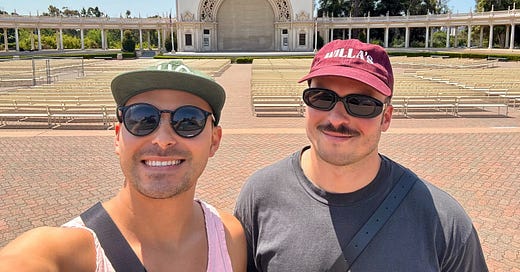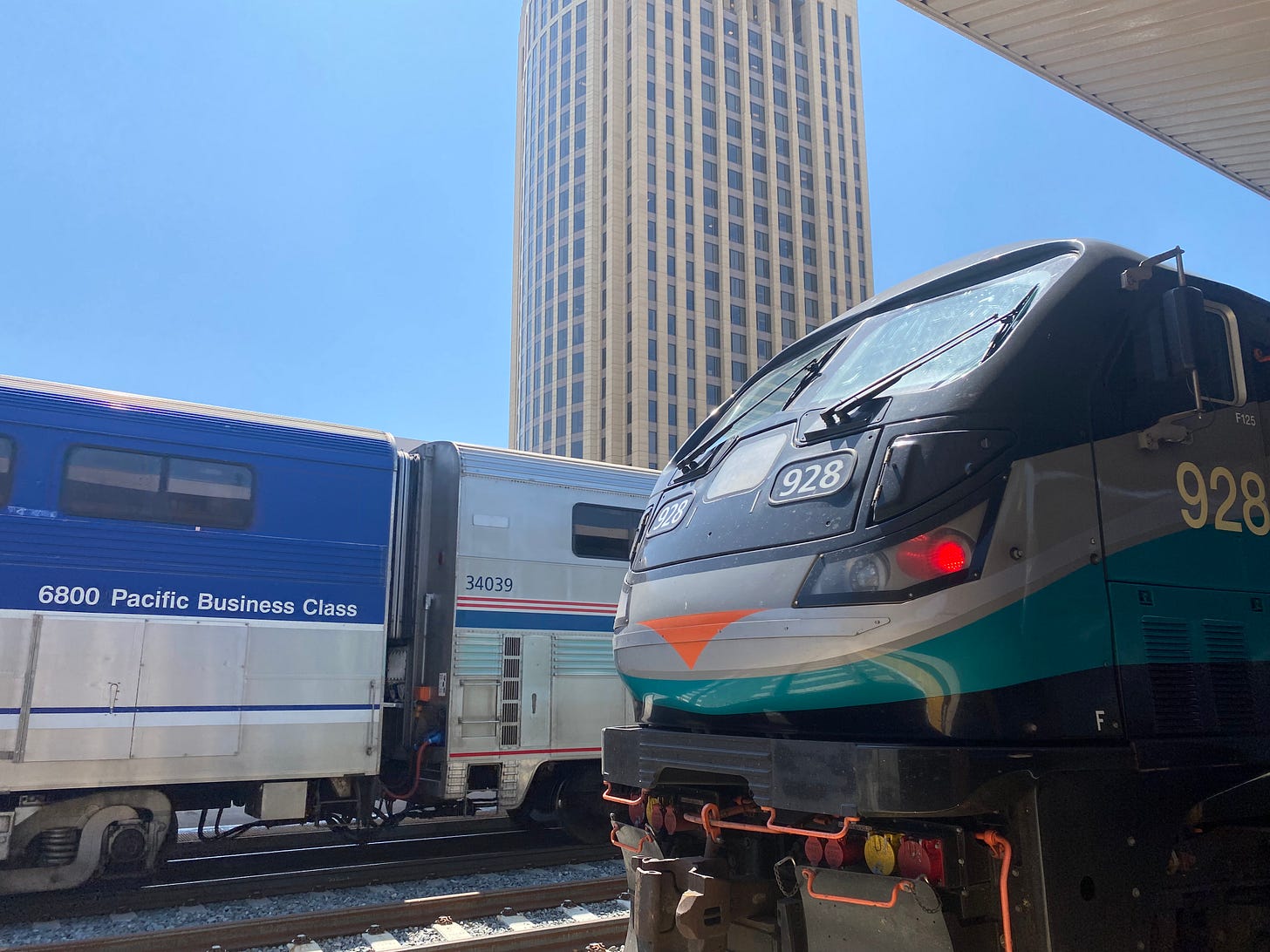I’ve lived as a nomad for the last two decades, which has afforded me a perspective on how cities are built, their differing qualities of life, and why walkability is key.
I’ve lived (or long-term stayed) in Tampa, Sarasota, Seattle, New York, Bordeaux, Milan, San Francisco, and now Los Angeles. The best aspects of all of them are the neighborhoods, local businesses, green spaces, public transit, and walkable districts.
Cars are a necessity in sprawly, spread-out cities, which includes much of the US. But the pockets of foot-level life are really the most magical and serendipitous parts of all cities. It’s where meet-cutes occur, neighbors get to know each other, and entrepreneurs thrive.
Seattle, New York, Bordeaux, Milan and San Francisco are all older cities and thus are intrinsically walkable, dense, urban, and relatively easy to traverse without a car. Their streets are narrower and cars are unable to get up to great speed between signals. From a parking perspective, cars are actually burdensome in these environments.
Sarasota, Tampa, and Los Angeles are almost totally the opposite. In their squarely automotive orientation, neighborhoods are bisected by wide boulevards and impassable highways, and cars are a requirement for daily movement. Anyone who walks along these bustling thoroughfares is thought to be in distress, be facing financial ruin, or have had their license revoked.
When cars are cheap and parking ample, everyone can afford to drive. But that’s changing. New and used car prices, insurance rates, and maintenance costs are all increasing faster than inflation. It’s also become apparent that driving in traffic affects our health negatively.
As a kid in Tampa, I lived on foot. Our house was in the Historic Hyde Park neighborhood, where century-old trees grazed the houses and shaded sidewalks. I could walk in almost any direction as far as I was allowed, without having to cross a major thoroughfare or stumble over a broken sidewalk. But this wasn’t the norm. Only the oldest parts of Tampa enjoyed this urban vibrancy.
Los Angeles is similar. Many of its oldest neighborhoods are quite walkable and the sidewalks are full of people at peak times. Just this past weekend I went out for drinks in Highland Park and was floored by how bustling the North Figueroa Street strip was on a Saturday night.
But busy streets full of rushing cars slice the city into ribbons, making it difficult to walk far without strange and uncomfortable crossings or imminent bodily danger. And we accept this, because LA is the center of American car culture.
Luckily, many formerly auto-dominated cities are in a state of change. Through intensive urban development and smart planning, Tampa’s busiest districts have densified and attracted throngs of young professionals moving from pricier cities. The city looks different than it did when I was growing up. It’s much more vertical.
A master-planned, car-free, infill community was recently completed in Phoenix, aiming to replicate the organic irregularity of a Mediterranean village. It’s a small scale (about 1,000 residents) but a great experiment in ways to redevelop cities and accommodate new populations without adding new sprawl.
Los Angeles is also making progress in densifying both old and new neighborhoods, but progress is slow. The city’s voters passed a resolution (HLA) in March to enforce the improvements defined in a 2035 mobility plan, which would change key roads in the city to better accommodate all modes, not just cars.
The city’s Transportation Department has already given key stretches of Hollywood Boulevard a “road diet”, shrinking lanes from four to two while adding protected bike lanes. And urban neighborhoods with mostly single-family homes are slowly becoming denser with multi-story, multi-family buildings with smaller units and common amenities.
Nevertheless, everyone I know looks on in horror at the endless stories of bicycle and pedestrian fatalities, wild police chases and dramatic crashes, street sideshows, and the commonly-accepted SoCal practice of cars running red lights two and three seconds after the signal has changed. It’s sickening. I’ve never once seen someone pulled over for red-light running.
179 pedestrians died in crashes in LA in 2023. That’s one every other day. The total number of deaths attributed to traffic collisions numbered 336, beating the number of deaths by homicide for the first time in a decade.
Los Angeles could be an even cooler city than it already is if it made walking, biking, and taking transit easier and driving just a little bit harder. While cars and trucks and buses and emergency vehicles need to traverse the city as fluidly as possible, and that’s unlikely to change, this shouldn’t come at the cost of basic pedestrian safety. With wide city streets and a culture of speeding and running red lights, Los Angeles feels like the most dangerous place to be a walker.
And perhaps for this reason, LA is a city of villages. People make choices about where to live based in part on what will be in their immediate vicinity, precisely because driving, traffic, and parking becomes so exhausting. But if they can’t or don’t feel comfortable enough to walk to these neighborhood spots, they might as well live in suburbia.
I love where I live—near Echo Park and Silver Lake. But if I want to walk any further, it’s better to drive. And this is true in so many cities, not just here in LA.
If we want healthier, happier, and safer cities, we must proactively reorient our transportation networks so that vehicles have designated spaces for rapid travel, and neighborhood locals have safe, pleasant spaces to socialize and build community. Cars alienate us, keeping us separate from one another—each in our private bubbles. They inspire us to race each other to the finish line or to exact revenge on someone who slights us, to the detriment of anyone or anything in our way.
Improvements on behalf of pedestrians and bicyclists would actually make the city more attractive, too. It’s wild to me that more streetscaping isn’t done on grand avenues like Sunset Boulevard, which traverses the entire city—about 24 miles uninterrupted—yet is consistently either clogged with traffic or totally empty.
Why not add a landscaped median down the middle, à la Mexico City or New Orleans? Those metros are equally or more population-dense, yet make pedestrians comfortable, relatively safe, and direct autos onto highways and ring roads rather than neighborhood surface streets.
To bemoan the historic loss of LA’s streetcars (see Who Framed Roger Rabbit) is fruitless now, but it deserves mention that the city and surrounding suburbs were once accessible by hundreds of miles of streetcar lines. What an incredible utopia that must have been.
What LA needs is a comprehensive campaign to dis-incentivize driving and make streets safer by giving them a diet, which includes shrinking lanes and adding more curbs and medians. This will slow cars down and encourage more people to take transit, which should be improved in unison. Something I learned as a planner is that lowering the speed limit actually increases overall volume moving through an area, because drivers feel more comfortable to be closer together. They spread out more when driving at higher speeds.
City leaders and urban planners need to choose key thoroughfares that will remain for cars primarily, but orient the remainder toward pedestrian, bicycle, and transit traffic. Reduce the number of freeway access points and offramps, and strongly punish those who treat the city and its streets like drag strips.
Too many people have already died in this city and others because they chose to walk in their neighborhood, use crosswalks, and enjoy the benefits of being on foot rather than driving. Less driving equals better air quality, fewer accidents, healthier and happier people, stronger communities, and fewer traffic-related 911 calls.
My dream LA needs just a few minor adjustments that will more than pay for themselves in a better quality of life. The only people who lose are those who want neighborhoods to remain a real-life game of Grand Theft Auto.
But is that what great cities are made of?






